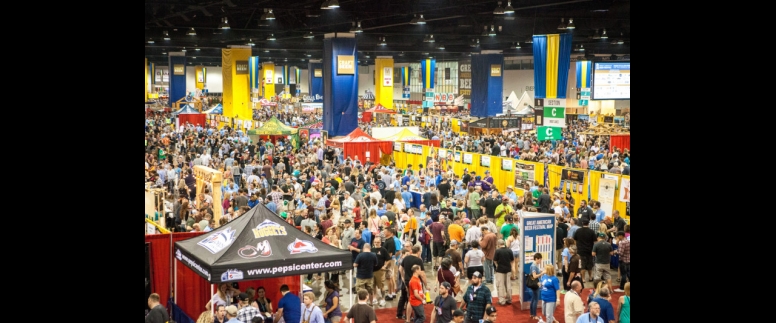
American Bars sampled a variety of reviews regarding the Great American Beer Festival -- held in Denver. A mashup of the results follows here:
The Great American Beer Festival swept through Denver last week. Upon entering the Colorado Convention Center for the Great American Beer Festival, all one hears and feels is the roar. It is the amalgamation of tens of thousands of people tasting beer and enjoying themselves, and it is very loud.
It is also the sound of change in the US beer market.
By many measures the largest beer festival in North America, the GABF presents an unparalleled snapshot of the state of beer in the US. Counted among the 780 breweries pouring their wares on the festival floor are small brewpubs producing a mere dozen or so barrels of beer a year, regional breweries with a presence in only a handful of states, the "new nationals" selling in all - or mostly all - states and frequently exporting to several countries besides, and the global brewing giants, pouring under both their own corporate banners and those of their recently-purchased craft properties.
In short, if a brewing trend is not apparent at the GABF, it's simply not that much of a trend. And, attending this, my 18th edition of the annual autumn event, I've grown quite used to spotting these trends, of which, in 2016, there were many.
Most obvious this year was the continued dominance of the India pale ale among craft beer styles. On the floor, it was hard to miss, as seemingly every second brewery - or even two out of every three - had an IPA of some sort on offer. In the GABF's beer competition, however, it was even more so. Of the 7,227 beers judged in 96 style categories at the 30th edition of the contest, which sees 264 judges working over three rigorous days of consuming beer (that’s a tall order…pun intended), 312 were classed as American-Style India Pale Ale, making it by some margin the most entered style. Impressive though this statistic may be, it tells only half the story, as a further 453 beers were entered in IPA-derivative categories, including the second most-entered, Imperial India Pale Ale, with 211 entries and Session India Pale Ale with 118.
Even so, there was some indication that IPA's long-standing dominant position in the American craft beer pantheon may be starting to slip ever so slightly. Entries in this year's main IPA category were down slightly from last year's 336, and other styles did appear to be on the rise, perhaps none more so than those gathered under the somewhat ill-fitting moniker of 'sour beer'.
Covering everything from low-alcohol Berliner “Weisse" beers and coriander- and salt-spiked “Goses", to wine barrel-aged 10% abv behemoths of complexity, so-called 'sours' -– most are more aptly described as tart and many bear little familial resemblance – seemed almost as ubiquitous as IPAs at the festival. However, with most of these beers made via a process known as 'kettle souring', in which wort is exposed to various bacteria prior to a sterilizing boil, it is easy to speculate that beer drinkers might soon tire of the relatively simple, 'one note" character this process tends to produce.
Another notable trend appeared to be an increase in the presence of lagered beers, both of the bottom- and top-fermented variety. While I was expecting to see growth in the number of pilsners and other pale lagers, I was surprised at the prevalence of lagered ale styles, such as the German Kölsch and Altbier and the American cream ale. Much as the arrival of German lager brewers to the US in the 1800s pushed mostly north-eastern ale breweries to develop the cold-conditioned cream ale, it seems as though the development of flagship lager brands by breweries such as Sierra Nevada and Firestone Walker might be spurring the renaissance of lagered ale styles among modern American craft brewers.
Finally, on a non-style specific note, I was fascinated to see the effect big brewery ownership has had on the booths of operations such as Goose Island and 10 Barrel, both Anheuser-Busch InBev-owned, and the recently MillerCoors-acquired Revolver – which was basically none at all. Despite predictions that craft beer loyalists would abandon these brands in droves, there was no shortage of line-ups at any of the acquired operations, whether they had grand end-aisle displays, as Goose Island did, or more low-key sampling stands.
Further, few people seemed to be shying away from still-independent but increasingly larger breweries like Sierra Nevada, Stone or the half-Heineken-owned Lagunitas.
The final result? Everyone is a winner. Beer is bigger than ever and far more diverse than ever imagined!




